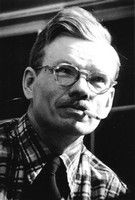Kenneth Stubbs |
 |
Kenneth Stubbs |
 |
|
News of Art and ArtistsThe Artists' Guild of Washington is holding its eighth annual exhibition, through October, in the foyer of the Natural History Building, National Museum. Forty-five artists are represented with one to three works each, a total of 86, filling the entire temporary exhibition space. The great majority of the exhibits are paintings in oil and water color, with a smaller number in gouache, tempera, casein and other media. Nine sculptures in wood, stone, or metal are prominently displayed, making them impressive in appearance if not in number. The guild does not favor any particular school or trend, but encourages individualism. Hence the show ranges from detailed naturalism to abstraction, which fact should guarantee something to suit every visitor's taste. Nearly all the exhibitors are Washington area artists. A few now living elsewhere used to be residents. Since many of the artists are frequent exhibitors, not only in guild but in other group shows as well as solos, there work is familiar. Viewing this annual, one is likely to reflect, "That is a typical Acheson," Gates, Maril or whatever. Even though the painting is being shown for the first time, it reveals some quality one has come to associate with the respective artist. Alice Acheson's beautiful "Saranac Valley," with her astringent greens and blues; John Gernand's "Evening Light," a peaceful landscape with eerie illumination and grayed colors; Henrietta Hoopes' two paintings with the detailed, clean-cut execution and surrealistic touch of her earlier works, are paintings in point. Lois Mailou Jones' views of France are fresh and sunny, of a piece with her many years' captures of that country in summer. John Chapman Lewis shows another romantic sea and shore painting, in soft, somber blue and gray. Herman Maril's "Clam Diggers" has the stripped-bare look of most of his paintings, assuring the observer of freedom from claustrophobia. William Calfee's "Apollo" impressed me as the best abstraction in the show, with satisfying arcs, curves and color scheme. This sun-god has a somewhat raffish suggestion, recalling Guido Reni's familiar painting of the subject, because it is so different. I also liked Leonard Maurer's abstract "Orchestra," Peter Blanc's "Searchlights" and William Thompson's "Kites" and "Air-vent," which last has a touch of Demuth in it. "St. Paul's Emerges" reveals the strength Eliot O'Hara habitually gets into water color. Aline Fruhauf and Richard Lahey contribute the only personal and social caricature, respectively. Kenneth Stubbs' "Positano" is an engaging glimpse of white buildings in sunshine. Prentiss Taylor's water color of "Potomac Bridges" does full justice to this subject dear to Washingtonians. "Lilacs" by John Robinson, extremely detailed in handling, and sentimental in subject, should prove popular. What the sculpture lacks in quantity it makes up in variety. I thought Maxim Elias' copper "Torso" one of the best things I have seen by him. Sarah Silberman's aluminum "Torso" and bayberry abstract nude are up to her usual standard. Leonare Thomas Strauss' little sandstone swimmer on a glazed ceramic wave is a piquant performance. Carl Nyquist's excursion into wood carving (new to me) has the flavor of folk art. Florence S. Berryman, Washington Sunday Star, Sunday, October 15, 1950
|
See also: Show Catalog Washington Times Herald Review |